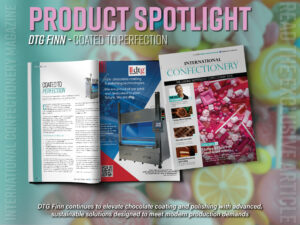International Confectionery talks with François Adele, General Manager, Dumoulin, about opportunities, challenges and trends we can expect to see in the confectionery industry this year.
Could you tell me about your involvement with the European Candy Kettle Club? What compelled you to join the club?
I joined the club in 2005, during which I’ve met a lot of great, nice and funny people. The European Candy Kettle Club consists of members from companies supplying ingredients and machinery in the confectionery industry, as well as some members of the trade press. I joined the club to make more connections, then I became a President of the Club for three years. I am now one of the oldest members and we are all great friends.
Dumoulin has a long history, going back to 1932. In that time, what have been major developments in coating for confectionery?
The company started in 1932. We are now in the third generation of Dumoulin; the fourth is already working in-house. Of course, there have been a lot of major developments in coating: automation and the size of the machine are major developments. Automation brings the manufacturer a way to have repeatability, but also ways to manage a big batch. The biggest challenge, I’d have to say, was transforming the art of panning into a science.
Coating or panning is like cooking. You can write a recipe down in a book but it’s not always so easy to follow the recipe and it’s difficult to manage. At the beginning of production, we need an expert in process to be able to implement all of the recipe. Once we’ve recorded a recipe in the system, we can control all the parameters and have repeatability to manage short, fast and reproducible batches.
As a science, what things can go wrong during the panning process?
It’s like cooking – so a lot of things can go wrong. Product can stick, it can make doubles, or it can make what we would regard as not nice product. The recipes we use are extremely long – when producing sugar coated lentils like M&Ms or Smarties, using a manual machine, this can take around 18 hours. Using an automated machine, however, this can take six hours. Six hours is still quite long. The goals we have in mind is creating a nice, smooth coloured food product, with a short process, while using as little energy as possible. We need to find a compromise between time, quality and energy.
As the first company to develop automated coating pans, do you think automation is the future of production? Do you see there being any challenges in adopting automated systems for confectionery producers?
Automation is a revolution in the confectionery production process and has brought about man benefits for manufacturers, such as increased efficiency, reduced labour cost, improved product quality and having greater consistency. Automatic systems such as an automatc coating pan to help confectionery manufacturers to increase productivity and reduce errors.
There are, however, some challenges associated with adopting automatic systems for confectionery production. One of the main challenges is the cost of the system, which can be high. This can make it difficult for smaller manufacturers to afford the necessary equipment. Another challenge is the technical expertise required to operate and maintain the system. A system can be complex and require skilled personnel to operate and maintain them, which can be a challenge for manufacturers who don’t have a dedicated technical team...
To read more see our latest issue here.
Media contact
Caitlin Gittins
Editor, International Confectionery
Tel: +44 (0) 1622 823 920
Email: [email protected]









